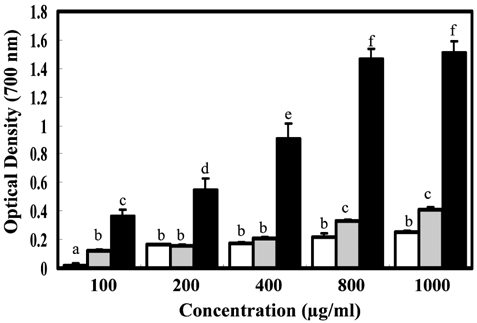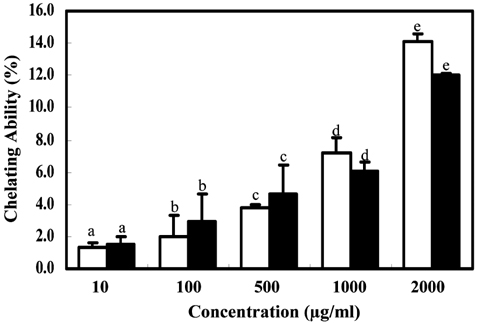Nutr Res Pract.
2008 Dec;2(4):247-251. 10.4162/nrp.2008.2.4.247.
Antioxidant and antidiabetic activities of extracts from Cirsium japonicum roots
- Affiliations
-
- 1School of Biotechnology, Kangwon National University, 192-1 Hyoja-dong, Chuncheon-si, Gangwon 200-701, Korea. mhwang@kangwon.ac.kr
- KMID: 2139199
- DOI: http://doi.org/10.4162/nrp.2008.2.4.247
Abstract
- This study investigated the antioxidant activity of methanol (MeOH) and water extracts from roots of Cirsium japonicum in vitro. MeOH extract showed a stronger free radical scavenging activity than water extract. However, both of extracts showed a concentration dependent hydroxyl radical scavenging activity, reducing power and metal chelating ability. MeOH extract had greater phenolic and flavonoid contents than water extract. The antidiabetic activity of these two extracts was evaluated by the alpha-glucosidase inhibition assay. The water extract showed a considerable alpha-glucosidase inhibitory activity. To our knowledge, this may be the first time to report the antioxidant and antidiabetic activities in Cirsium japonicum roots.
MeSH Terms
Figure
Reference
-
1. Ames B. Micronutrients prevent cancer and delay aging. Toxicol Lett. 1998. 102:5–18.
Article2. Athukorala Y, Kim KN, Jeon YJ. Antiproliferative and antioxidant properties of an enzymatic hydrolysate from brown alga, Ecklonia cava. Food Chem Toxicol. 2006. 44:1065–1074.
Article3. Cakir A, Mavi A, Yildirim A, Duru ME, Harmandar M, Kazaz C. Isolation and characterization of antioxidant phenolic compounds from the aerial parts of Hypericum hyssopifolium L. by activity-guided fractionation. J Ethnopharmacol. 2003. 87:73–83.
Article4. Chang CC, Yang MH, Wen HM, Chern JC. Estimation of total flavonoid content in propolis by two complementary colorimetric methods. Journal of Food Drug Analysis. 2002. 10:178–182.5. Das NP, Pereira TA. Effects of flavonoids on thermal autoxidation of palm oil: structure- activity relationships. J Am Oil Chem Soc. 1990. 67:255–258.
Article6. Decker EA. Phenolics: prooxidants or antioxidants? Nutr Rev. 1997. 55:396–407.
Article7. Donguibogam. 1999. Seoul. Republic of Korea: Bubin Publishers Co.;1942.8. Ganzera M, Pocher A, Stuppner H. Differentiation of Cirsium japonicum and Cirsium setosum by TLC and HPLC-MS. Phytochem Anal. 2005. 16:205–209.9. Gordon MH. Hudson BJF, editor. The mechanism of antioxidant action in vitro. Food antioxidants. 1990. London. UK: Elsevier Applied Science;1–18.
Article10. Hagerman AE, Riedl KM, Jones GA, Sovik KN, Ritchard NT, Hartzfeld PW. High molecular weight plant polyphenolics (Tannins) as biological antioxidants. J Agric Food Chem. 1998. 46:1887–1892.
Article11. Halliwell B. Antioxidant characterization: methodology and mechanism. Biochem Pharmacol. 1995. 49:1341–1348.12. Halliwell B, Gutteridge JMC, Cross CE. Free radicals, antioxidants, and human disease: Where are we now? J Lab Clin Med. 1992. 119:598–620.13. Huxley RR, Neil H. The relationship between dietary flavonol intake and coronary heart disease mortality: a metaanalysis of prospective cohort studies. Eur J Clin Nutr. 2003. 57:904–908.
Article14. Inzucchi SE. Oral antihyperglycemic therapy for type 2 diabetes: scientific review. JAMA. 2002. 287:360–372.15. Kalt W, Forney CF, Martin A, Prior RL. Antioxidant capacity, vitamin C, phenolics, and anthocyanins after fresh storage of small fruits. J Agric Food Chem. 1999. 47:4638–4644.
Article16. Liu SJ, Luo X, Li DX, Zhang J, Qiu DL, Liu W, She L, Yang ZR. Tumor inhibition and improved immunity in mice treated with flavone from Cirsium japonicum DC. International Immunopharmacology. 2006. 6:1387–1393.
Article17. Loo AY, Jain K, Darah I. Antioxidant and radical scavenging activities of the pyroligneous acid from a mangrove plant, Rhizophora apiculata. Food Chem. 2007. 104:300–307.
Article18. Mensor LL, Menezes FS, Leitao GG, Reis AS, Dos Santos TC, Coube CS, Leitao SG. Screening of Brazilian plant extracts for antioxidant activity by the use of DPPH free radical method. Phytother Res. 2001. 15:127–130.
Article19. Nazaruk J, Jakoniuk P. Flavonoid composition and antimicrobial activity of Cirsium rivulare (Jacq.) all flowers. J Ethnopharmacol. 2005. 102:208–212.
Article20. Oki T, Masuda M, Furuta S, Nishibia Y, Terahara N, Suda I. Involvement of anthrocyanins and other phenolic compounds in radical scavenging activity of purple-fleshed sweet potato cultivas. Food Chem. 2002. 67:1752–1756.
Article21. Osawa T. Novel Natural Antioxidants for Utilization in Food and Biological Systems. 1994. Tokyo. Japan: Japan Scientific Scoieties Press;241–251.22. Rhabasa LR, Chiasson JL. Defronzo RA, Ferrannini E, Keen H, Zimmet P, editors. Alpha-glucosidase inhibitors. International textbook of diabetes mellitus. 2004. Vol. 1:3rd ed.UK: John Wiley.23. Siriwardhana N, Lee KW, Kim SH, Ha WJ, Jeon YJ. Antioxidant activity of Hizikia fusiformis on reactive oxygen scavenging and lipid peroxidation inhibition. Food Science and Technology International. 2003. 9:339–346.
Article24. Siriwardhana SSKW, Shahidi F. Antiradical activity of extracts of almond and its by-products. J Am Oil Chem Soc. 2002. 79:903–908.
Article25. Soares JR, Dins TCP, Cunha AP, Ameida LM. Antioxidant activity of some extracts of Thymus zygis. Free Radic Res. 1997. 26:469–478.26. Weisburger JH, Hara Y, Sulan L, Luo FQ, Pittman B, Zang E. Tea polyphenols as inhibitors of mutigenicity of major classes carcionogens. Mutat Res. 1996. 371:57–63.
Article27. Yamaguchi F, Ariga T, Yoshimira Y, Nakazawa H. Antioxidant and anti-glycation of carcinol from Garcinia indica fruit rind. J Agric Food Chem. 2000. 48:180–185.
Article28. Yen GC, Chen HY. Antioxidant activity of various tea extracts in relation to their antimutagenicity. J Agicr Food Chem. 1995. 43:27–32.
Article29. Yin Y, Heo SI, Wang MH. Antioxidant and anticancer activities of methanol and water extracts from leaves of Cirsium japonicum. J Appl Biol Chem. 2008. 51:160–164.
Article30. Zhang X, Koo J, Eun JB. Antioxidant activities of methanol extracts and phenolic compounds in Asian pear at different stages of maturity. Food Sci Biotechnol. 2006. 15:44–50.31. Zheng W, Wang SY. Antioxidant activity and phenolic compounds in selected herbs. J Agric Food Chem. 2001. 49:5165–5170.
Article
- Full Text Links
- Actions
-
Cited
- CITED
-
- Close
- Share
- Similar articles
-
- Effects of Elsholtzia splendens and Cirsium japonicum on premenstrual syndrome
- RNA-Seq De Novo Assembly and Differential Transcriptome Analysis of Korean Medicinal Herb Cirsium japonicum var. spinossimum
- Assessment of In vitro Antioxidant, Antidiabetic and Cytotoxic Activities of Sphaeranthus africanus Extracts
- Inhibitory effect of Erythronium japonicum on the human breast cancer cell metastasis
- Ethanol Extract of Cirsium japonicum var. ussuriense Kitamura Exhibits the Activation of Nuclear Factor Erythroid 2-Related Factor 2-dependent Antioxidant Response Element and Protects Human Keratinocyte HaCaT Cells Against Oxidative DNA Damage




